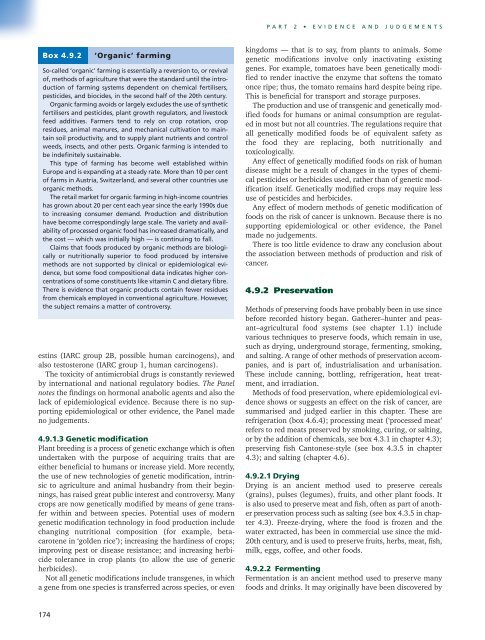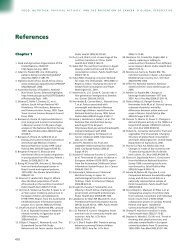Full Report - Food, Nutrition, and the Prevention of Cancer
Full Report - Food, Nutrition, and the Prevention of Cancer
Full Report - Food, Nutrition, and the Prevention of Cancer
You also want an ePaper? Increase the reach of your titles
YUMPU automatically turns print PDFs into web optimized ePapers that Google loves.
Box 4.9.2 ‘Organic’ farming<br />
So-called ‘organic’ farming is essentially a reversion to, or revival<br />
<strong>of</strong>, methods <strong>of</strong> agriculture that were <strong>the</strong> st<strong>and</strong>ard until <strong>the</strong> introduction<br />
<strong>of</strong> farming systems dependent on chemical fertilisers,<br />
pesticides, <strong>and</strong> biocides, in <strong>the</strong> second half <strong>of</strong> <strong>the</strong> 20th century.<br />
Organic farming avoids or largely excludes <strong>the</strong> use <strong>of</strong> syn<strong>the</strong>tic<br />
fertilisers <strong>and</strong> pesticides, plant growth regulators, <strong>and</strong> livestock<br />
feed additives. Farmers tend to rely on crop rotation, crop<br />
residues, animal manures, <strong>and</strong> mechanical cultivation to maintain<br />
soil productivity, <strong>and</strong> to supply plant nutrients <strong>and</strong> control<br />
weeds, insects, <strong>and</strong> o<strong>the</strong>r pests. Organic farming is intended to<br />
be indefinitely sustainable.<br />
This type <strong>of</strong> farming has become well established within<br />
Europe <strong>and</strong> is exp<strong>and</strong>ing at a steady rate. More than 10 per cent<br />
<strong>of</strong> farms in Austria, Switzerl<strong>and</strong>, <strong>and</strong> several o<strong>the</strong>r countries use<br />
organic methods.<br />
The retail market for organic farming in high-income countries<br />
has grown about 20 per cent each year since <strong>the</strong> early 1990s due<br />
to increasing consumer dem<strong>and</strong>. Production <strong>and</strong> distribution<br />
have become correspondingly large scale. The variety <strong>and</strong> availability<br />
<strong>of</strong> processed organic food has increased dramatically, <strong>and</strong><br />
<strong>the</strong> cost — which was initially high — is continuing to fall.<br />
Claims that foods produced by organic methods are biologically<br />
or nutritionally superior to food produced by intensive<br />
methods are not supported by clinical or epidemiological evidence,<br />
but some food compositional data indicates higher concentrations<br />
<strong>of</strong> some constituents like vitamin C <strong>and</strong> dietary fibre.<br />
There is evidence that organic products contain fewer residues<br />
from chemicals employed in conventional agriculture. However,<br />
<strong>the</strong> subject remains a matter <strong>of</strong> controversy.<br />
estins (IARC group 2B, possible human carcinogens), <strong>and</strong><br />
also testosterone (IARC group 1, human carcinogens).<br />
The toxicity <strong>of</strong> antimicrobial drugs is constantly reviewed<br />
by international <strong>and</strong> national regulatory bodies. The Panel<br />
notes <strong>the</strong> findings on hormonal anabolic agents <strong>and</strong> also <strong>the</strong><br />
lack <strong>of</strong> epidemiological evidence. Because <strong>the</strong>re is no supporting<br />
epidemiological or o<strong>the</strong>r evidence, <strong>the</strong> Panel made<br />
no judgements.<br />
4.9.1.3 Genetic modification<br />
Plant breeding is a process <strong>of</strong> genetic exchange which is <strong>of</strong>ten<br />
undertaken with <strong>the</strong> purpose <strong>of</strong> acquiring traits that are<br />
ei<strong>the</strong>r beneficial to humans or increase yield. More recently,<br />
<strong>the</strong> use <strong>of</strong> new technologies <strong>of</strong> genetic modification, intrinsic<br />
to agriculture <strong>and</strong> animal husb<strong>and</strong>ry from <strong>the</strong>ir beginnings,<br />
has raised great public interest <strong>and</strong> controversy. Many<br />
crops are now genetically modified by means <strong>of</strong> gene transfer<br />
within <strong>and</strong> between species. Potential uses <strong>of</strong> modern<br />
genetic modification technology in food production include<br />
changing nutritional composition (for example, betacarotene<br />
in ‘golden rice’); increasing <strong>the</strong> hardiness <strong>of</strong> crops;<br />
improving pest or disease resistance; <strong>and</strong> increasing herbicide<br />
tolerance in crop plants (to allow <strong>the</strong> use <strong>of</strong> generic<br />
herbicides).<br />
Not all genetic modifications include transgenes, in which<br />
a gene from one species is transferred across species, or even<br />
174<br />
P ART 2 • EVIDENCE AND JUDGEMENTS<br />
kingdoms — that is to say, from plants to animals. Some<br />
genetic modifications involve only inactivating existing<br />
genes. For example, tomatoes have been genetically modified<br />
to render inactive <strong>the</strong> enzyme that s<strong>of</strong>tens <strong>the</strong> tomato<br />
once ripe; thus, <strong>the</strong> tomato remains hard despite being ripe.<br />
This is beneficial for transport <strong>and</strong> storage purposes.<br />
The production <strong>and</strong> use <strong>of</strong> transgenic <strong>and</strong> genetically modified<br />
foods for humans or animal consumption are regulated<br />
in most but not all countries. The regulations require that<br />
all genetically modified foods be <strong>of</strong> equivalent safety as<br />
<strong>the</strong> food <strong>the</strong>y are replacing, both nutritionally <strong>and</strong><br />
toxicologically.<br />
Any effect <strong>of</strong> genetically modified foods on risk <strong>of</strong> human<br />
disease might be a result <strong>of</strong> changes in <strong>the</strong> types <strong>of</strong> chemical<br />
pesticides or herbicides used, ra<strong>the</strong>r than <strong>of</strong> genetic modification<br />
itself. Genetically modified crops may require less<br />
use <strong>of</strong> pesticides <strong>and</strong> herbicides.<br />
Any effect <strong>of</strong> modern methods <strong>of</strong> genetic modification <strong>of</strong><br />
foods on <strong>the</strong> risk <strong>of</strong> cancer is unknown. Because <strong>the</strong>re is no<br />
supporting epidemiological or o<strong>the</strong>r evidence, <strong>the</strong> Panel<br />
made no judgements.<br />
There is too little evidence to draw any conclusion about<br />
<strong>the</strong> association between methods <strong>of</strong> production <strong>and</strong> risk <strong>of</strong><br />
cancer.<br />
4.9.2 Preservation<br />
Methods <strong>of</strong> preserving foods have probably been in use since<br />
before recorded history began. Ga<strong>the</strong>rer–hunter <strong>and</strong> peasant–agricultural<br />
food systems (see chapter 1.1) include<br />
various techniques to preserve foods, which remain in use,<br />
such as drying, underground storage, fermenting, smoking,<br />
<strong>and</strong> salting. A range <strong>of</strong> o<strong>the</strong>r methods <strong>of</strong> preservation accompanies,<br />
<strong>and</strong> is part <strong>of</strong>, industrialisation <strong>and</strong> urbanisation.<br />
These include canning, bottling, refrigeration, heat treatment,<br />
<strong>and</strong> irradiation.<br />
Methods <strong>of</strong> food preservation, where epidemiological evidence<br />
shows or suggests an effect on <strong>the</strong> risk <strong>of</strong> cancer, are<br />
summarised <strong>and</strong> judged earlier in this chapter. These are<br />
refrigeration (box 4.6.4); processing meat (‘processed meat’<br />
refers to red meats preserved by smoking, curing, or salting,<br />
or by <strong>the</strong> addition <strong>of</strong> chemicals, see box 4.3.1 in chapter 4.3);<br />
preserving fish Cantonese-style (see box 4.3.5 in chapter<br />
4.3); <strong>and</strong> salting (chapter 4.6).<br />
4.9.2.1 Drying<br />
Drying is an ancient method used to preserve cereals<br />
(grains), pulses (legumes), fruits, <strong>and</strong> o<strong>the</strong>r plant foods. It<br />
is also used to preserve meat <strong>and</strong> fish, <strong>of</strong>ten as part <strong>of</strong> ano<strong>the</strong>r<br />
preservation process such as salting (see box 4.3.5 in chapter<br />
4.3). Freeze-drying, where <strong>the</strong> food is frozen <strong>and</strong> <strong>the</strong><br />
water extracted, has been in commercial use since <strong>the</strong> mid-<br />
20th century, <strong>and</strong> is used to preserve fruits, herbs, meat, fish,<br />
milk, eggs, c<strong>of</strong>fee, <strong>and</strong> o<strong>the</strong>r foods.<br />
4.9.2.2 Fermenting<br />
Fermentation is an ancient method used to preserve many<br />
foods <strong>and</strong> drinks. It may originally have been discovered by



